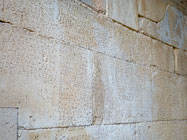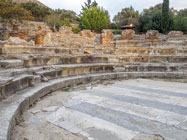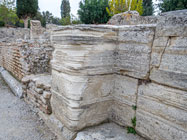|
Home
Page 1/3 (this page)
Page 2/3
Page 3/3



|
The origin of marble from ancient times: Gortyna (Crete)
webpage 1/3
Text: Annemieke van Roekel, geoscience journalist
More articles: www.vuurberg.nl.
This article was first published in Gea Magazine (June 2022).
The origin of natural stone in ancient architecture and sculpture can be traced by
studying the rock at a micro level. Three Italian universities determined the origin of marble
from the Greco-Roman city of Gortyna (South Crete) and knew exactly from which quarries
in the Aegean area it was extracted about 2000 years ago.
This archaeometric research, in which the provenance of natural stone is determined
using techniques based on earth sciences, has grown enormously in recent decades.
Museums that have sculptures in their collection increasingly want to know what the
source of the natural stone is. Marble from the ancient city of Gortyna on Crete
(also called Gortys or Gortyn), has also been subjected to
mineralogical and petrological research. The Italian researchers conclude that
the marble mainly comes from the Attica Peninsula and the islands of Paros and Thasos.
The quarries could also be identified.
Messara Valley
Gortyna is located not far from the archaeological site of the two millennia older Minoan Phaistos,
on the south side of Central Crete, in the Messara Plain, between the Psiloritis Mountains in the north
and the Asterousia Mountains in the south.
From the late 7th century BC, Gortyna was an important city, best known for the Gortyn code of
laws, discovered in 1884, legal texts (fig. 1) engraved in the limestone walls of the agora
(market place). They are considered the oldest in Greece (and Europe). The odeon, a small amphitheatre from the first century BC,
is situated next to the agora (fig. 2 and 3).



Fig. 1. The famous Gortyn Code from the fifth century BC includes legal texts
of civil law. Fig. 2. The small amphitheatre in the evening sun. Fig. 3. Layered
limestone blocks that surround the amphitheatre. Photo's: A. van Roekel.
Page 1/3
Page 2/3
Page 3/3
Top photo: Andreas Fischer-Happel.
Copyright: Annemieke van Roekel
Last update: January 9, 2025
|